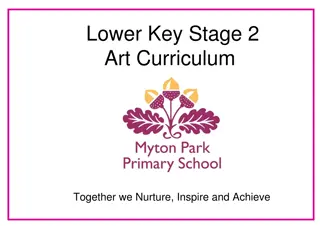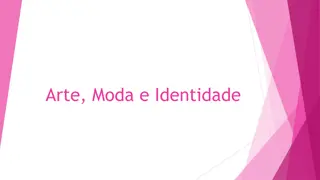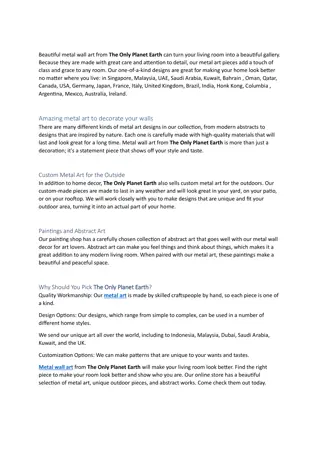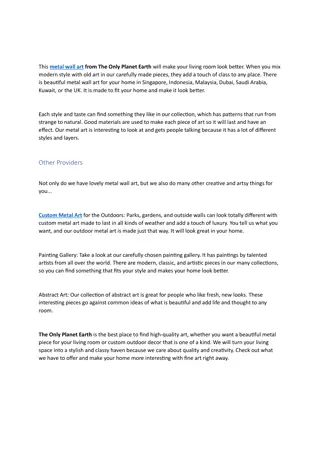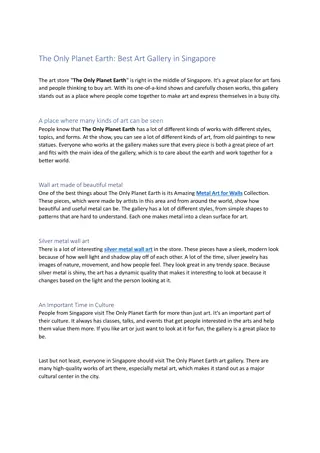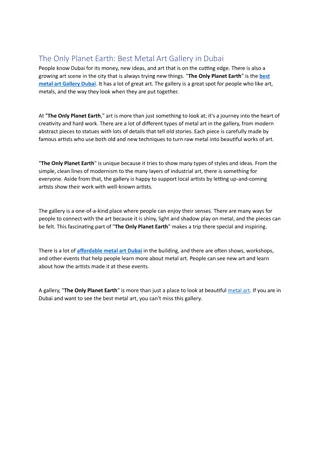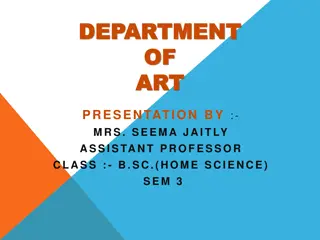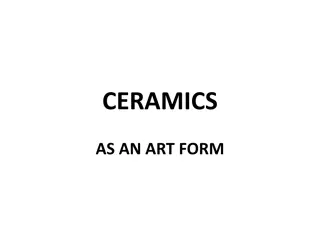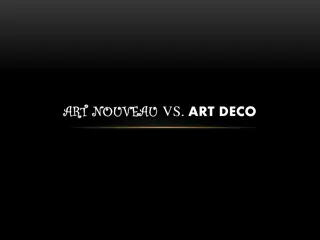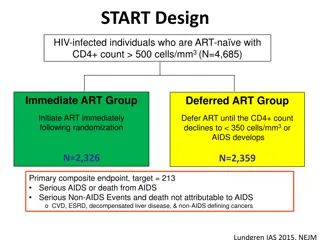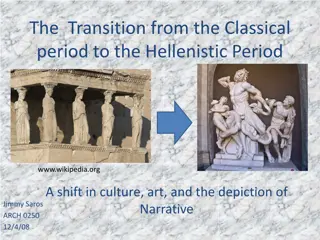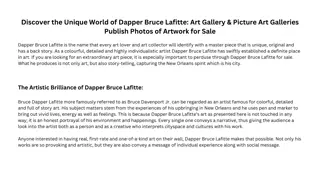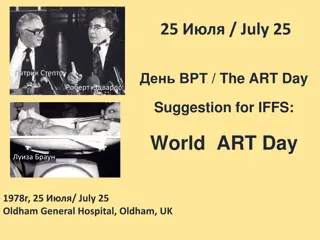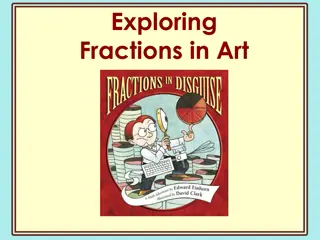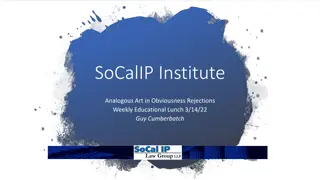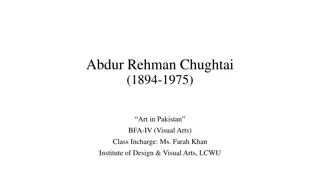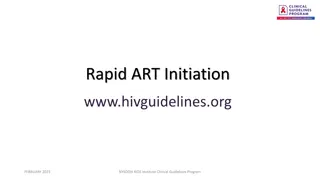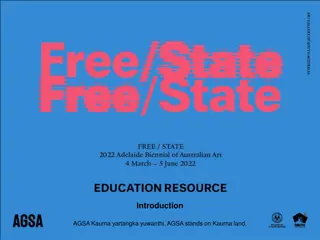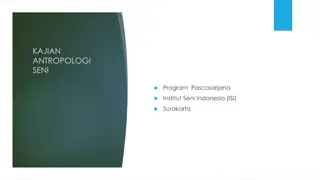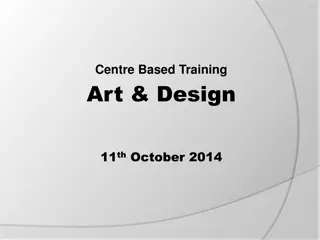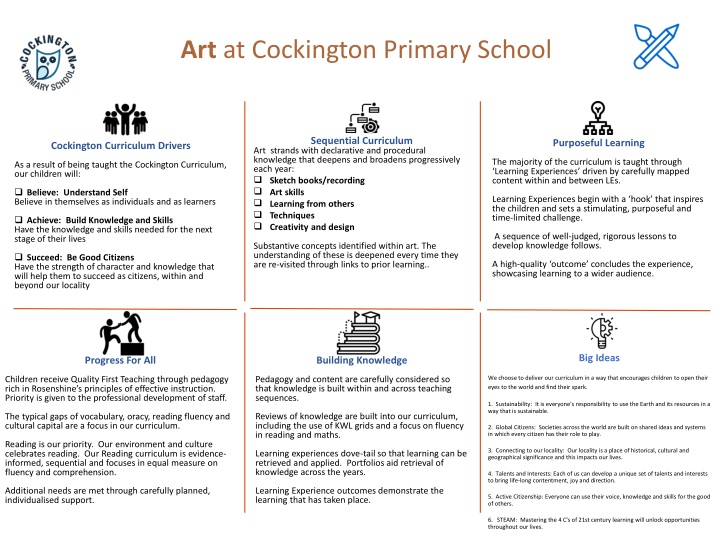
Purposeful Learning Through Cockington Primary School Art Curriculum
Immerse in a sequential art curriculum at Cockington Primary School, fostering creativity, skills, and global citizenship. Explore sustainability, talent development, and active citizenship as key themes, enriching students' experiences and knowledge through engaging teaching sequences. Develop artistic abilities, self-belief, and a passion for art to prepare students for success in various aspects of life. Dive into the world of art and design, building a foundation for lifelong learning and creativity.
Download Presentation

Please find below an Image/Link to download the presentation.
The content on the website is provided AS IS for your information and personal use only. It may not be sold, licensed, or shared on other websites without obtaining consent from the author. If you encounter any issues during the download, it is possible that the publisher has removed the file from their server.
You are allowed to download the files provided on this website for personal or commercial use, subject to the condition that they are used lawfully. All files are the property of their respective owners.
The content on the website is provided AS IS for your information and personal use only. It may not be sold, licensed, or shared on other websites without obtaining consent from the author.
E N D
Presentation Transcript
Art at Cockington Primary School Sequential Curriculum Purposeful Learning Cockington Curriculum Drivers Art strands with declarative and procedural knowledge that deepens and broadens progressively each year: Sketch books/recording Art skills Learning from others Techniques Creativity and design The majority of the curriculum is taught through Learning Experiences driven by carefully mapped content within and between LEs. As a result of being taught the Cockington Curriculum, our children will: Believe: Understand Self Believe in themselves as individuals and as learners Learning Experiences begin with a hook that inspires the children and sets a stimulating, purposeful and time-limited challenge. Achieve: Build Knowledge and Skills Have the knowledge and skills needed for the next stage of their lives A sequence of well-judged, rigorous lessons to develop knowledge follows. Substantive concepts identified within art. The understanding of these is deepened every time they are re-visited through links to prior learning.. Succeed: Be Good Citizens Have the strength of character and knowledge that will help them to succeed as citizens, within and beyond our locality A high-quality outcome concludes the experience, showcasing learning to a wider audience. Big Ideas Building Knowledge Progress For All Pedagogy and content are carefully considered so that knowledge is built within and across teaching sequences. Children receive Quality First Teaching through pedagogy rich in Rosenshine s principles of effective instruction. Priority is given to the professional development of staff. We choose to deliver our curriculum in a way that encourages children to open their eyes to the world and find their spark. 1. Sustainability: It is everyone's responsibility to use the Earth and its resources in a way that is sustainable. Reviews of knowledge are built into our curriculum, including the use of KWL grids and a focus on fluency in reading and maths. The typical gaps of vocabulary, oracy, reading fluency and cultural capital are a focus in our curriculum. 2. Global Citizens: Societies across the world are built on shared ideas and systems in which every citizen has their role to play. Reading is our priority. Our environment and culture celebrates reading. Our Reading curriculum is evidence- informed, sequential and focuses in equal measure on fluency and comprehension. 3. Connecting to our locality: Our locality is a place of historical, cultural and geographical significance and this impacts our lives. Learning experiences dove-tail so that learning can be retrieved and applied. Portfolios aid retrieval of knowledge across the years. 4. Talents and Interests: Each of us can develop a unique set of talents and interests to bring life-long contentment, joy and direction. Learning Experience outcomes demonstrate the learning that has taken place. Additional needs are met through carefully planned, individualised support. 5. Active Citizenship: Everyone can use their voice, knowledge and skills for the good of others. 6. STEAM: Mastering the 4 C's of 21st century learning will unlock opportunities throughout our lives.
Art at Cockington Primary School MTP Driver subject 2020-21 Intent: At Cockington Primary School, we aim to establish a passion for art by providing experiences that all children, of all academic levels can access helping them to develop their skills, knowledge and appreciation and enjoyment of art. We aim to encourage children to have a go , to believe in themselves and become a creative Colin in order to boost their confidence and feel a sense of achievement as an artist. Our Art and Design curriculum ensures that children explore, imagine, and create. Through engaging practice, communication, and a dive into the importance of Art and Design, children are equipped with the knowledge and skills to experiment, invent and create their own works of art. Children are taught to embrace the journey of an artist, to understand the importance of making and experimenting. We recognise the importance of our children having knowledge and understanding of art in the wider world, to broaden their understanding of the multiple forms of art and to take inspiration from this.
Art at Cockington Primary School Content We re Going on a Bear Hunt Once Upon a Time Purposeful Learning: Hook Read the story We re Going on a Bear Hunt . Children arrive to find a big dark cave in their learning space. Who could live in the cave? Where are they? Why do they live here? How will we find them? The Three Little Pigs: Someone has left a mess in the classroom, but can the children figure out who? A trail of straw and sticks have been left behind, along with a tuft of grey fur! Who could it be? Why is there a mess? What happened? Purposeful Learning: Outcome Retelling the story to an Audience of Year 1 children. Use all of the outside area to re-enact the story in small groups, filmed to share with parents. To invite the children's parents in to share and celebrate their work (the houses they have built/ to give the gingerbread man they have designed and baked to a special person in their family). Oracy- Use of a story maps to use for talk for writing. Using the Stem sentence, 'I mixed the colours ..to make .' Reading- The 3 Little Pigs, The Gingerbread Man. Vocabulary- primary colours, design. Cultural Capital- knowledge of how to design and prepare food. Progress for All Oracy opportunity for children to discuss their family Brown Bear, Brown Bear Stem Sentences : 'I can see the colour .' Reading Going on a Bear Hunt (T4W text) Vocabulary- colour, texture Cultural Capital-Awareness and knowledge of own family and place within the larger school community. EYFS Art LE Overview I can use a range of techniques to create a Bear Hunt story map freeze: To explore what happens when they mix colours to create green grass. To experiment to create different textures to create snow. To understand that different media can be combined to create new effects to create a water effect. To manipulate materials to achieve a planned effect, tearing paper to create grass. I can plan and create a Bear Trap. To construct with a purpose of catching a teddy bear in mind, using a variety of resources. To use simple tools and techniques competently and appropriately. To select the appropriate resources and adapt work where necessary. To select tools and techniques needed to shape, assemble and join materials they are using. I can mix colours to paint pink pigs To explore what happens when they mix colours to make the pink colour for their pig.. I can design and make a Gingerbread Bread Men To explore and experiment with the dough to create different textures. To understand that different media can be combined to create new effects. To manipulate ingredients to achieve a planned effect. To construct with a purpose in mind, using a variety of resources. To use simple cooking tools and techniques competently and appropriately. To select the appropriate resources and adapt work where necessary. To select tools and techniques needed to shape, assemble and join the dough. Representing their own ideas, thoughts and feelings through the design of their gingerbread man. Sequential Curriculum Building Curiosity - Children may be inspired by the story of the Bear Hunt to look closely at the environment, for example considering colours and different shades of green. Creativity and imagination in the classroom. Awe and Wonder- children wonder at how colours can be manipulated and changed by their combining choices. Citizenship Healthy lives- children may be inspired to go for walks in our local environment with their families. Awe and Wonder- Wonder- children wonder at how colours can be manipulated and changed by their combining choices. Celebrating diversity and achievement- the children will share their creations and learning with their parents when taking the gingerbread man home. Creativity and imagination- Children use imagination and creativity to create their own unique gingerbread man design. Big Ideas Building Knowledge This driver builds the foundations for the Carrot Caf LE in Y1. Art skills: Colour mixing, collage, Foundations for The Gruffalo LE in Y1 use of a book to inspire creativity This driver builds the foundations for the Carrot Caf LE in Y1. Art skills: Colour mixing, collage, Foundations for The Gruffalo LE in Y1 control of materials to create a 3D product
Art at Cockington Primary School ELG: Colour mixing, primary colours, patterns, simple tools, collage, photography Taught Vocabulary Sketch Art skills Learning from others Techniques Creativity and design books/recording Welcome to Cockington: Mix Palette Tear snip Print Paste Spread I can create a Bear hunt story map freeze created through colour mixing, collage, and printing. I can name and use primary colours. I can describe collections of colour. To experiment to create different textures. I can take account of one ideas of others about how to organise my activity. I can experiment with paint. I can experiment with collage. I can experiment with drawing. I can build and demolish. We re going on a bear Hunt . EYFS Art Sequential Knowledge I can make simple patterns. Seasons and celebrations I can record my observations. I can experiment with photography. I can enjoy sensory experiences. I can collect, sort and discuss objects. The lost world I can colour mix to make a pig character. I can design, bake and decorate Gingerbread biscuit. I can mix colours. I can use curves and lines with different tools. I can take account of one ideas of others about how to organise my activity. I can experiment with paint. I can construct with a purpose in mind, using a variety of resources. I can use simple tools and techniques competently and appropriately. I can make choices to reflect my own ideas. Once upon a time Design Cutter Shape
Art at Cockington Primary School Carrot Cafe Content The Gruffalo Invite a 'chef' to talk to the children, make pizzas (or a similar food product) and use some of the ingredients to make faces on the pizzas. Introduce the children to the idea that fruit and veg could represent parts of a face. Trip to Haldon looking at sculptures on Gruffalo trail. Children invited to improve playground by adding their own Gruffalo trail could this unit link with forest school so that children could make their own Gruffalo sculptures for their trail using wood and natural resources that they have collected? Purposeful Learning: Hook Selling of children's Arcimboldo style fruit artwork at Carrot Club Caf celebration. Gruffalo trail displaying children's Axel Scheffler inspired artwork (Gruffalo clay models and sketches). Purposeful Learning: Outco me Progress for All Oracy opportunity for children to comment on likes/dislikes and plan and evaluate both their own and Arcimboldo's artwork. Reading Oliver's Fruit Salad (T4W text) Cultural Capital-Awareness and knowledge of a differentartist, their role and how the world around them inspires their work. Oracy- exchanging ideas with others during the outcome and throughout the sessions. Instruction: explaining the process of creating Gruffalo sculptures to visitors at the outcome. Reading- The Gruffalo (T4W text) Year 1 Art LE Overview Sketch books/recording Art skills Learning from others Collage techniques Pastel, paint/chalk techniques Creativity and design Substantive Concepts- To be able to review own work and that of others considering impact and use of space, shapes and patterns. Sketch books/recording Art skills Learning from others Control of materials Drawing techniques Form/creating a 3D object Creativity and design Substantive Concepts- To be able to review own work and that of others. Sequential Curriculum Building Curiosity - Children may be inspired by the work of Arcimboldo and find the different skills such as collage interesting. This may then inspire the children to experiment and take risks within their own artwork. Creativity and imagination in the classroom. Big Ideas in Citizenship Healthy lives (link to fruit and vegetables and healthy eating). Building Curiosity trip/using the outdoor environment to enhance learning. Invitation to construct a Gruffalo trail on their very own playground. Children may also be inspired by their favourite storybook characters and the by the work of a popular children's illustrator. Creativity and imagination in the classroom. Big Ideas in Citizenship Our Place in the World Big Ideas Builds on: 'Going on a bear Hunt' in EYFS. Art skills: Colour mixing, collage, Foundations from Once upon a time use of a book and others to inspire creativity. This driver builds the foundations from We re going on a bear hunt in EYFS. Art skills: Colour mixing, collage, Build upon control of materials to create a 3D product from Once upon a time in EYFS. Building Knowledge Builds towards: Great Fire of London LE in Y2. Art skills: colour mixing, primary and secondary colours. Learning from others Wassily Kandinsky, Lieve Verschuier Polar adventures Y3 use of tones and hot and cold colours Raiders and Traders - Y4 pastel, paint, chalk techniques Builds towards: 'Mother nature designers' Y4 creating printing tiles. Creating 3D product Location, location, location Y5 skill of perspective and 3D design 'Ancients' Y6 control of tools with accuracy and control to create 3D product.
Art at Cockington Primary School Taught Vocabulary Sketch books/reco rding Art skills Learning from others Techniques Creativity and design Carrot Caf Artist, interpretation, portrait, collage, technique, primary colours, secondary colours. I can record observations. I can revisit and improve my art. I can review my work. Colour: I can name and use primary and secondary colours. I can mix primary colours to make secondary colours. I can use lighter and darker colours in my art. Shape and Line: I can use lines to represent an object. Space: I can consider how my piece of art will look as a whole. I can give my opinions about the work of artists and begin to think about why. I can use collage techniques to develop my art skills. I can use drawing techniques with pencil, pastels and chalks to develop my art skills. I can use art to share my ideas, experiences and imagination. 1. Fruit and vegetables inspire Arcimboldo's artwork. 2. To be able to name two challenges of collage 3. To explain how paint can be made lighter and darker 4. To name three items that can represent parts of a face. 5. To name two primary and two secondary colours. Year 1 Art Sequential Knowledge I can record observations. I can revisit and improve my art. I can review my work. Control of materials and Tools: I can use a range of materials and tools safely and carefully Form: I can create a 3D form of an object. I can use painting techniques to develop my art skills using block paints. I can use thick and thin lines to sketch using pencil. I can learn about and give an opinion about a famous illustrator I can use junk modelling sculpture techniques to develop my art skills. I can use art to share my ideas, experiences and imagination. The Gruffalo Sculpture, illustrator, modell ing, observations, trail. 1. An illustrator is someone who draws pictures for books. 2. Alex Scheffler and Quentin Blake are two famous illustrators. 3. Light lines are created by holding a pencil and pressing softly. 4. Dark lines are made by pressing harder with a pencil. 5. A sculpture is the art of making three-dimensional shape .
Art at Cockington Primary School Taught Vocabulary Sketch Art skills Learning from others Techniques Creativity and design books/recording A silhouette is a black outline of an object. Silhouette Architecture Urban Landscape scenery Tone Interpretation Blending I can record observations. I can revisit and improve my art. I can review my work. Colour: I can name and use primary and secondary colours. I can mix primary colours to make secondary colours. I can use lighter and darker colours in my art. Shape and Line: I can use lines to represent an object. I can give my opinions about the work of artists and begin to think about why. I can use painting techniques to develop my art skills using block paints. I can use art to share my ideas, experiences and imagination. Primary colours can be mixed to make secondary colours e.g. yellow and blue make green Van Gough A skyline is an outline of land and buildings against the sky Year 2 Art Sequential Knowledge Artist study one Black paint makes colours darker and white paints make colours lighter Texture: I can make choices about texture in my art. Control of materials and Tools: I can use a range of materials and tools safely and carefully I can give my opinions about the work of artists and begin to think about why. I can use collage techniques to develop my art skills. I can use art to share my ideas, experiences and imagination. 1. There are different stitching techniques that can be used to produce art such as cross stich and running stitch. Texture Collage Fabric stitching Form: I can create a 3D form of an object. I can use fabric printing, simple stitching and dying to develop my art skills. 2. Artists use different materials such as fabric and plastic to create an effect. 3. Artists such as Hiroshi Fuji use recycled materials to produce art work. 4. Cross stitch is a stitch formed of two stitches crossing each other 5. Running stitch is a stitch consisting of a line of small even stitches which run back and forth through the cloth without overlapping
Art at Cockington Primary School Content Polar Adventures Art in Stone age times - claywork Depending on animal chosen, children to be introduced to art and prints inspired by the polar region and then visit later in the year 2020 David Attenbourgh letter Stone age day to immerse the children into the period of time. Day will include selection of art work. Purposeful Learning: Hook Charity event to showcase art work created. Sharing with parents learning carried out and skills developed during the LE. Purposeful Learning: Outc ome Oracy- Children to discuss their own print work giving reasons (process, evaluation) Cultural capital: artwork from various artists inspired by animals Reading: Focus Strands: Techniques printing Creativity and Design Art skills complimentary tones Oracy- Children to discuss their own work giving reasons (process, evaluation) Cultural capital: Roman artwork left in Britain Reading: Escape from Pompeii Progress for All Year 3 Art LE Overview Focus strands: Art skills Learning from others Sequential Curriculum Building curiosity Through exploring art skills, children may discover talents and interests through their art work. Creativity and imagination in the classroom. Big Ideas in Citizenship: to understand raising money for charity can support public places Awe and Wonder: Appreciation of artists and their use primary and secondary colourin representing temperature. Building curiosity: through exploring art skills, children may discover talents and interests through their art work. Creativity and imagination in the classroom. Big Ideas in Citizenship: civilizations can achieve great things when they work together Awe and Wonder: Appreciation of artists and how history has helped shape Britian Big Ideas Builds on: 'Going on a bear Hunt' in EYFS. Art skills: Colour mixing, collage, Once upon a time EYFS - use of a book and other artists to inspire creativity. Great Fire of London LE in Y2. Art skills: colour mixing, primary and secondary colours. Learning from others Wassily Kandinsky, Lieve Verschuier Builds on: 'Going on a bear Hunt' in EYFS. Art skills: Colour mixing, collage, Once upon a time EYFS - use of a book and other artists to inspire creativity. Great Fire of London LE in Y2. Art skills: colour mixing, primary and secondary colours. Learning from others Wassily Kandinsky , Lieve Verschuier Building Knowledge Builds towards: Raiders and traders - Y4 pastel, paint, chalk techniques Mother nature designers Y4 - printing techniques Mystical magic or serious science Y5 painting techniques and greater accuracy when using tools Ancients Y6 Greater use of accuracy and control when using tools to create 3D products Builds towards: Raiders and traders - Y4 pastel, paint, chalk techniques Mother nature designers Y4 - printing techniques Mystical magic or serious science Y5 painting techniques and greater accuracy when using tools Ancients Y6 Greater use of accuracy and control when using tools to create 3D products
Art at Cockington Primary School Taught Vocabulary Sketch Art skills Learning from others Techniques Creativity and design books/recording How can we fix our climate? Complimentary Tones Warm Cool mood I can create a sketch book to record my observations. Colour: I can name and use primary, secondary and complimentary colours. I can mix tones of different colours. I can use hot and cold colours in my art. Control of materials and Tools: I can show greater control in the use of a variety of tools and materials. I can make choices about the tools and materials which fit the job. I can give my opinions about the work of artists and give reasons for my opinion. Name of two artists Who are they? I can use printing techniques to develop my art skills. I can use powder paints and watercolour painting techniques to develop my art skills. I can take in to account the purpose of my art when designing and creating. Warm colours are said to advance towards you as if they are jumping out of the painting. A colour mixture becomes warmer as more red is added to it A colour mixture cools as blue is added. Warm and cool colours can be used together to create a sense of drama, to add interest and contrast to artwork. Cool colours are said to recede into the background, meaning that they move away from the viewer. Year 3 Art Sequential Knowledge I can use my sketch book to review and revisit ideas. Pattern: I can experiment with formal and informal patterns. I can design and make patterns for a design purpose. Shape and Line: I can make accurate shapes and lines in my art through careful observation. Texture: I can consider texture as part of a sculpture. I can use my knowledge of artists to influence my own art. I can give my opinions about the work of artists and give reasons for my opinion. Local photographer and William Morris. I can use photography techniques to develop skills. Looking from different angles and in different lights. I can use drawing techniques with pencil and charcoal to develop my art skills. I can use creativity and experiences to design my art. Mother Nature Designers shadow William Morris is an artist that is famous for producing art inspired by nature. I can experiment and improve my art. design Printmaking is the process of creating artworks by printing, normally on paper, but also on fabric, wood, metal, and other surfaces. I can take in to account the purpose of my art when designing and creating. To create a printing tile. angle There are five main camera angles to choose from. Each one adds a different perspective, giving photos the mood or feeling that you want it to have. print tile Artists use light thought out carefully to create the mood they want in a photograph. Photography is the process or practice of creating a photograph an image produced by the action of light on a light-sensitive material.
Art at Cockington Primary School Taught Vocabulary Sketch Art skills Learning from others Techniques Creativity and design books/recording Clay Relief Texture Natural purpose I can create a sketch book to record my observations. Control of materials and Tools: I can show greater control in the use of a variety of tools and materials. I can make choices about the tools and materials which fit the job. Pattern: I can experiment with formal and informal patterns. I can design and make patterns for a design purpose. Texture: I can consider texture as part of a sculpture. Form: I can use relief to create 3D aspects in my artwork. I can give my opinions about the work of artists and give reasons for my opinion. I can use my knowledge of artists to influence my own art. I can use sculpture techniques to develop my art skills, including natural materials. I can take in to account the purpose of my art when designing and creating. People during the Stone Age first started using clay pots to cook food and store things. Year 3 Art Sequential Knowledge I can use my sketch book to review and revisit ideas. Clay was shaped into pots for storing and cooking food. To make larger pots,coils of clay were added to the thumb pots. Potters call this process hand building To make a clay pot, natural clay is crushed before adding water. Most small pots were made as pinch pots or thumb pots working from a single ball of clay.
Art at Cockington Primary School Content How did the arrival of the Romans change Britain? Virtual art gallery and use of the book A street through time . Focus on Lowrey and Monay and their style of painting to inspire and enthuse the children into creating their own. Purposeful Learning: Hook Children to create A street through time based in Lowry style paintings depicting Torquay in an iron age settlement, and then a Roman settlement. Pictures to be displayed at Torre Abbey. Purposeful Learning: Outcom e Oracy- Discussion: exchanging ideas with others during the outcome and throughout the sessions. Progress for All Instruction: telling someone what to do, or explaining facts in the outcome. Year 4 Art LE Overview Reading- Cultural Capital- learning about influential artisits Focus strands- Sketch books/recording Shape and line Drawing techniques Water colour and powder paint techniques Substantive concepts- To be able to make decisions on line, shape and patterns having an understanding of the intended effect. Sequential Curriculum Big Ideas Through exploring art skills, children may discover talents and interests through their art work. Creativity and imagination in the classroom. Builds on: 'Going on a bear Hunt' - EYFS- Experimenting with paint and drawing. 'Carrot Caf ' -Year 1 - Naming primary and secondary colours. - Y2- Naming primary and secondary colours. Mixing primary colours to make secondary. Lighter and darker effects. 'Polar Adventures ' - Year 3-Use of tones and hot and cold colours. Building Knowledge Builds towards: 'Mystical magic or serious science' - y5 colour mixing using acrylics, replicating art of others
Art at Cockington Primary School Taught Vocabulary Sketch Art skills Learning from others Techniques Creativity and design books/recordi ng How did the arrival of the Romans change Britain? 1. L.S.Lowry painted urban cityscapes with a na ve style and simple perspective. 2. Claude Monet s painted natural landscapes using an impressionist style. 3. Landscape art is the depiction of natural and urban scenery, especially where the main subject is a wide view. 4. Landscape art has been an important way of capturing an artist s interpretation of moments in history. 5. Artists are influenced by others when creating their own art and can explain how their work is influenced. Interpretati on Perspective Impressionis m Industrial technique I can use my sketch book to review and revisit ideas. Shape and Line: I can make accurate shapes and lines in my art through careful observation. Drawing techniques Water colour and powder paint techniques I can use my knowledge of artists to influence my own art. Lowry Britain at Play . https://www.bbc.co.u k/teach/class-clips- video/art-and-design- ks2-ls-lowrys-britain- at-play/zvkskmn I can use drawing techniques with pencil and charcoal to develop my art skills. I can use creativity and experiences to design my art. I can experiment and improve my art. I can take in to account the purpose of my art when designing and creating. Year 4 Art Sequential Knowledge I can give my opinions about the work of artists and give reasons for my opinion.
Art at Cockington Primary School Content Location, Location, Location Purposeful Learning: Hook As part of the hook, the local estate agent will explain about the artwork that they will need to include in their final piece of work. This could be a view of the street, view of property or just a room in the property. Purposeful Learning: Outcome The final pieces of artwork will be judged/ evaluated by the estate agent based on their effectiveness in helping to sell the property. Have they used architectural drawing techniques? Have they used tools and materials with control and accuracy to produce precise and realistic art? Progress for All Oracy presentation of their finished piece to the estate agent, using the correct vocabulary to explain the process they went through to create the final piece. Vocab Using and understanding the vocab specific to the experience e.g. perspective, vanishing point, composition, shading etc. Cultural Capital The role of an estate agent/ architect as a future career. Learning about the financial demands of owning a home and needing a good education to secure an income (aspirations of the home they would like in the future) Year 5 Art LE Overview Sketch books /recording I can create a sketch book to record my observations. I can use my sketch book to review and revisit ideas. Techniques I can use architectural drawing techniques to develop my art skills Sequential Curriculum Building Curiosity What does an estate agents/ architects job entail? How can you become an estate agent? What qualifications do you need? How do they choose the artwork / photographs to be used in the property details? Big Ides in Citizenship STEM (technology / engineering) Our place in the world Where we live / where I would like to live / career as an estate agent / architect Big Ideas Building Knowledge Builds on: The lost world' - EYFS-Experimenting with photography. 'Carrot Caf ' - Year 1 giving opinions of the work of artists 'Great Fire of London' Y2 giving opinions about the work of artists. 'Polar adventures' -Y3- giving opinions on the work of artists and explaining reasons why, printing techniques 'Mother nature designers' - y4 greater control when using tools to create printing tile Builds towards: 'Ancients' - Y6 control and accuracy when producing 3D products
Art at Cockington Primary School Taught Vocabulary Sketch books/recording Art skills Learning from others Techniques Creativity and design Agatha Christie Sculpture Accuracy Realistic I can create a sketch book to record my observations. Shape and Line: I can use tools and materials with control and accuracy to produce precise and realistic art. Angel of the north Anthony Gormley I can use base materials and sculpture techniques to develop my art skills, such as clay, wire and modroc. I can use creativity and experiences to design my art. Sculptures are decorative, 3D forms of art that have been in existence for centuries. Anthony Gormley, Henry Moore and Giacometti I can use my sketch book to review and revisit ideas. I can experiment and improve my art. Control of materials and Tools: I can use a range of tools and materials with control and accuracy. There are four main techniques for shaping clay: Roughing Out. Adding Clay. Removing Clay. Maneuvering Clay. I can take in to account the purpose of my art when designing and creating. * Year 5 Art Sequential Knowledge I can explain my decision making processes for the art I create. Sculptors use four basic techniques. They either take (carve) away or add materials (construction) to create the sculpture. Anthony Gormley is a famous English sculptor who has created sculptures all around the world, including The Angel of the North in Gateshead. Clay is a naturally occurring sticky fine grained earth. It can be molded into different shapes. Clay is used to make bricks, potteries, and ceramics. It is also used to make sculptures and decorative patterns and designs
Art at Cockington Primary School Taught Vocabulary Sketch Art skills Learning from others Techniques Creativity and design books/recording I can create a sketch book to record my observations, including identifying the lines of perspective and vanishing point on drawings and photographs, sketching a view of the street using the skill of perspective and drawing a room using the skill of perspective. I can use my sketch book to review and revisit ideas. Shape and Line: I can use tools and materials with control and accuracy to produce precise and realistic art. Form: I can create realistic 2D representations of 3D objects using perspective and shading. Space: I can consider pros and cons of different compositions before making my choice. Other famous architects: Wren I can use architectural drawing techniques to develop my art skills, including the skill of creating perspective in my artwork. I can take in to account the purpose of my art when designing and creating. my final persuasive piece using architectural drawing techniques, tools and materials with control and accuracy. Location, Location, Location We use the skill of perspective to create 2D representations of 3D objects. The vanishing point is the spot on the horizon where the lines of perspective meet. An architect is a person who designs buildings. An architect uses architectural techniques with control and accuracy to produce precise and realistic art. Perspective Vanishing point Architect / Architectural Composition 3 Dimensional Year 5 Art Sequential Knowledge
Art at Cockington Primary School Content Photography Darwin Purposeful Learning: Hook Tore Abbey greenhouse to take previous photography used in Y3 to take up close photos of plants. Secondary art teacher to share lesson on photography Purposeful Learning: Outcom e Progress for All Outcome to include an online gallery so families and wider school community can view children s photographs taken of nature and their stop motion videos showing their learning and understanding of evolution. Oracy: children discuss ideas and improve ideas of photography work. Children to practice editing and improving photography skills ready for sharing online. Cultural capital: opportunity to showcase photographs in an online gallery and receive feedback from those who view them. Learn about secondary school opportunities Year 6 Art LE Overview Sequential Curriculum I can use photography techniques to develop my art skills. Children to look at photographs of nature and think and discuss what is good about them, what techniques have been used and which are most effective to take a successful photograph. Children will practise taking photographs and thinking about lighting and angles. Children will practise editing and improving photos using skills such as cropping and adding filters to enhance colours, brightness etc. Children will create a collection of photographs linked to nature and our science topic. Children will showcase these photos in an online gallery. Big Ideas Building creativity - New interests and talents discovered through immersion in different stye of art and tools used to create a successful photo gallery. Inspire awe and wonder in discovering how to enhance, edit and improve photos and then share them and receive feedback.
Art at Cockington Primary School Taught Vocabulary Sketch books/recording Art skills Learning from others Techniques Creativity and design I can create a sketch book to record my observations. Shape and Line: I can use tools and materials with control and accuracy to produce precise and realistic art. I can critique the art of others I can use photography techniques to develop my art skills. I can explain my decision making processes for the art I create. What methods did Darwin use to develop his theory of evolution? I can use my sketch book to review and revisit ideas. Abstract Realistic Precise Filter Exposure Focus Tilt Angle I can use creativity and experiences to design my art. Artists use different styles and techniques to suit their purpose I can experiment and improve my art. Artists use portfolios to record observations and to review and revisit ideas. Year 6 Art Sequential Knowledge Georgia O'Keeffe (1887-1986 was an American modern artist who is known for painting landscapes and plants in an abstract style. Charles Darwin and Conrad Martens documented the journey of the Beagle with their observational drawings and paintings. Filers an angles can be used to turn a realistic photograph into an abstract

